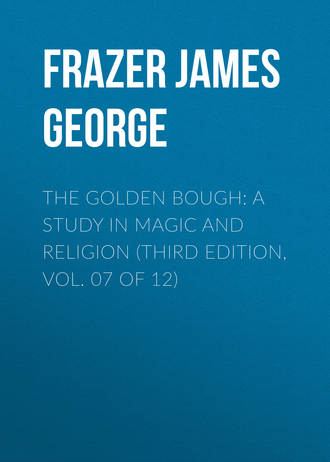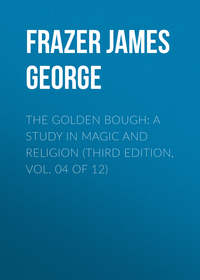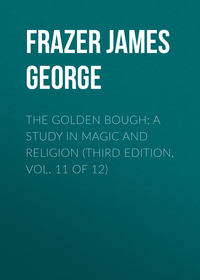
The Golden Bough: A Study in Magic and Religion (Third Edition, Vol. 07 of 12)
608
A. C. Kruijt, “Gebruiken bij den rijstoogst in enkele streken op Oost-Java,” Mededeelingen van wege het Nederlandsche Zendelinggenootschap, xlvii. (1903) pp. 132-134. Compare id., “De rijst-moeder in den Indischen Archipel,” Verslagen en Mededeelingen der koninklijke Akademie van Wetenschappen, Afdeeling Letterkunde, Vierde Reeks, v. part 4 (Amsterdam, 1903), pp. 398 sqq.
609
J. C. van Eerde, “Gebruiken bij den rijstbouw en rijstoogst op Lombok,” Tijdschrift voor Indische Taal- Land- en Volkenkunde, xlv. (1902) pp. 563-565 note.
610
J. C. van Eerde, “Gebruiken bij den rijstbouw en rijstoogst op Lombok,” Tijdschrift voor Indische Taal- Land- en Volkenkunde, xlv. (1902) pp. 563-573.
611
(Sir) J. G. Scott and J. P. Hardiman, Gazetteer of Upper Burma and the Shan States, Part i. vol. i. (Rangoon, 1900) p. 426.
612
Maximilian, Prinz zu Wied, Reise in das innere Nord-America (Coblenz, 1839-1841), ii. 182 sq.
613
H. R. Schoolcraft, Indian Tribes of the United States, v. (Philadelphia, 1856) pp. 193-195.
614
B. A. Gupte, “Harvest Festivals in honour of Gauri and Ganesh,” Indian Antiquary, xxxv. (1906) p. 61. For details see The Magic Art and the Evolution of Kings, ii. 77 sq.
615
It is possible that the image of Demeter with corn and poppies in her hands, which Theocritus (vii. 155 sqq.) describes as standing on a rustic threshing-floor (see above, p. 47), may have been a Corn-mother or a Corn-maiden of the kind described in the text. The suggestion was made to me by my learned and esteemed friend Dr. W. H. D. Rouse.
616
Homer, Odyssey, v. 125 sqq.; Hesiod, Theog. 969 sqq.
617
See above, pp. 150 sq.
618
It is possible that a ceremony performed in a Cyprian worship of Ariadne may have been of this nature: at a certain annual sacrifice a young man lay down and mimicked a woman in child-bed. See Plutarch, Theseus, 20: ἐν δὴ τῇ θυσίᾳ τοῦ Γορπιαίου μηνὸς ἰσταμένου δευτέρᾳ κατακλινόμενόν τινα τῶν νεανίσκων φθέγγεσθαι καὶ ποιεῖν ἅπερ ὠδινοῦσαι γυναῖκες. We have already seen grounds for regarding Ariadne as a goddess or spirit of vegetation. See The Magic Art and the Evolution of Kings, ii. 138. Amongst the Minnitarees in North America, the Prince of Neuwied saw a tall strong woman pretend to bring up a stalk of maize out of her stomach; the object of the ceremony was to secure a good crop of maize in the following year. See Maximilian, Prinz zu Wied, Reise in das innere Nord-America (Coblenz, 1839-1841), ii. 269.
619
See The Magic Art and the Evolution of Kings, ii. 97 sqq.
620
See above, p. 135.
621
See above, pp. 140 sqq., 155 sqq., 164 sqq., 197 sqq.
622
However, the Sicilians seem on the contrary to have regarded Demeter as the seed-corn and Persephone as the ripe crop. See above, pp. 57, 58 sq.
623
According to Augustine (De civitate Dei, iv. 8) the Romans imagined a whole series of distinct deities, mostly goddesses, who took charge of the corn at all its various stages from the time when it was committed to the ground to the time when it was lodged in the granary. Such a multiplication of mythical beings to account for the process of growth is probably late rather than early.
624
In some places it was customary to kneel down before the last sheaf, in others to kiss it. See W. Mannhardt, Korndämonen, p. 26; id., Mythologische Forschungen, p. 339. The custom of kneeling and bowing before the last corn is said to have been observed, at least occasionally, in England. See Folk-lore Journal, vii. (1888) p. 270; and Herrick's evidence, above, p. 147, note 1. The Malay sorceress who cut the seven ears of rice to form the Rice-child kissed the ears after she had cut them (W. W. Skeat, Malay Magic, p. 241).
625
Above, pp. 132 sq.
626
Even in one of the oldest documents, the Homeric Hymn to Demeter, Demeter is represented as the goddess who controls the growth of the corn rather than as the spirit who is immanent in it. See above, pp. 36 sq.
627
W. G. Aston, Shinto (London, 1905), p. 127.
628
See Adonis, Attis, Osiris, Second Edition, pp. 323 sqq., 330 sqq., 346 sqq.
629
A. Pauly, Real-Encyclopädie der classischen Alterthumswissenschaft, v. (Stuttgart, 1849) p. 1011.
630
Diodorus Siculus, i. 14, ἔτι γὰρ καὶ νῦν κατὰ τὸν θερισμὸν τοὺς πρώτους ἀμηθέντας στάχυς θέντας τοὺς ἀνθρώπους κόπτεσθαι πλησίον τοῦ δράγματοσ καὶ τὴν Ἶσιν ἀνακαλεῖσθαι κτλ. For θέντας we should perhaps read σύνθεντας, which is supported by the following δράγματος.
631
Herodotus, ii. 79; Julius Pollux, iv. 54; Pausanias, ix. 29. 7; Athenaeus, xiv. 11, p. 620 a.
632
H. Brugsch, Die Adonisklage und das Linoslied (Berlin, 1852), p. 24. According to another interpretation, however, Maneros is the Egyptian manurosh, “Let us be merry.” See Lauth, “Über den ägyptischen Maneros,” Sitzungsberichte der königl. bayer. Akademie der Wissenschaften zu München, 1869, ii. 163-194.
633
Above, pp. 197 sqq.
634
W. R. S. Ralston, Songs of the Russian People (London, 1872), pp. 249 sq.
635
See above, pp. 158 sq.
636
W. Gregor, “Quelques coutumes du Nord-est du comté d'Aberdeen,” Revue des Traditions populaires, iii. (1888) p. 487 (should be 535).
637
Homer, Iliad, xviii. 570; Herodotus, ii. 79; Pausanias, ix. 29. 6-9; Conon, Narrat. 19. For the form Ailinus see Suidas, s. v.; Euripides, Orestes, 1395; Sophocles, Ajax, 627. Compare Moschus, Idyl. iii. 1; Callimachus, Hymn to Apollo, 20. See Greve, s. v. “Linos,” in W. H. Roscher's Ausführliches Lexikon der griech, und röm. Mythologie, ii. 2053 sqq.
638
Conon, Narrat. 19.
639
F. C. Movers, Die Phönizier, i. (Bonn, 1841), p. 246; W. Mannhardt, Antike Wald- und Feldkulte (Berlin, 1877), p. 281. In Hebrew the expression would be oï lanu (אוי לנו), which occurs in 1 Samuel, iv. 7 and 8; Jeremiah, iv. 13, vi. 4. However, the connexion of the Linus song with the lament for Adonis is regarded by Baudissin as very doubtful. See W. W. Graf Baudissin, Adonis und Esmun (Leipsic, 1911), p. 360, note 3.
640
Pausanias, ix. 29. 8.
641
Julius Pollux, iv. 54; Athenaeus, xiv. 11, pp. 619 f-620 a; Hesychius, svv. Βῶρμον and Μαριανουνὸς θρῆνος.
642
The story was told by Sositheus in his play of Daphnis. His verses have been preserved in the tract of an anonymous writer. See Scriptores rerum mirabilium Graeci, ed. A. Westermann (Brunswick, 1839), pp. 220 sq.; also Athenaeus, x. 8, p. 415 b; Scholiast on Theocritus, x. 41; Photius, Lexicon, Suidas, and Hesychius, s. v. “Lityerses”; Apostolius, Centur. x. 74; Servius, on Virgil, Bucol. viii. 68. Photius mentions the sickle with which Lityerses beheaded his victims. Servius calls Lityerses a king and says that Hercules cut off his head with the sickle that had been given him to reap with. Lityerses is the subject of a special study by W. Mannhardt (Mythologische Forschungen, pp. 1 sqq.), whom I follow. Compare O. Crusius, s. v. “Lityerses,” in W. H. Roscher's Ausführliches Lexikon der griech. und röm. Mythologie, ii. 2065 sqq.
643
Julius Pollux, iv. 54.
644
In this comparison I closely follow W. Mannhardt, Mythologische Forschungen, pp. 18 sqq.
645
Compare above, pp. 134, 136, 137 sq., 140, 142, 143, 144, 145, 147 sq., 149, 164 sq. On the other hand, the last sheaf is sometimes an object of desire and emulation. See above, pp. 136, 141, 153, 154 sq., 156, 162 note 3, 165. It is so at Balquhidder also (Folk-lore Journal, vi. 269); and it was formerly so on the Gareloch, Dumbartonshire, where there was a competition for the honour of cutting it, and handfuls of standing corn used to be hidden under sheaves in order that the last to be uncovered should form the Maiden. – (From the information of Archie Leitch. See pp. 157 sq.)
646
W. Mannhardt, Mythologische Forschungen, pp. 19 sq.
647
A. Kuhn, Märkische Sagen und Märchen (Berlin, 1843), p. 342.
648
W. Mannhardt, Mythologische Forschungen, p. 20; F. Panzer, Beitrag zur deutschen Mythologie (Munich, 1848-1855), ii. p. 217, § 397; A. Witzschel, Sagen, Sitten und Gebräuche aus Thüringen (Vienna, 1878), p. 222, § 69.
649
Above, pp. 167 sq.
650
W. Mannhardt, Mythologische Forschungen, p. 22.
651
W. Mannhardt, Mythologische Forschungen, p. 22.
652
Ibid. pp. 22 sq.
653
Ibid. p. 23.
654
Ibid. pp. 23 sq.
655
Ibid. p. 24.
656
Ibid. p. 24.
657
Ibid. p. 24.
658
Ibid. pp. 24 sq.
659
Ibid. p. 25.
660
P. Drechsler, Sitte, Brauch und Volksglaube in Schlesien (Leipsic, 1903-1906), ii. 65.
661
A. Witzschel, Sagen, Sitten und Gebräuche aus Thüringen (Vienna, 1878), p. 223, § 70.
662
W. Mannhardt, Mythologische Forschungen, pp. 25 sq.
663
C. A. Elliot, Hoshangábád Settlement Report, p. 178, quoted in Panjab Notes and Queries, iii. §§ 8, 168 (October and December, 1885); W. Crooke, Popular Religion and Folklore of Northern India (Westminster, 1896), ii. 306.
664
W. Crooke, op. cit. ii. 306 sq.
665
W. Mannhardt, Mythologische Forschungen, p. 31.
666
Ibid. p. 334.
667
Ibid. p. 330.
668
Ibid.
669
Ibid. p. 331.
670
W. Mannhardt, Mythologische Forschungen, p. 335.
671
Ibid. p. 335.
672
Above, pp. 135, 146.
673
J. Nicholson, Folk-lore of East Yorkshire (London, Hull, and Driffield, 1890), p. 28, supplemented by a letter of the author's addressed to Mr. E. S. Hartland and dated 33 Leicester Street, Hull, 11th September, 1890. I have to thank Mr. E. S. Hartland for calling my attention to the custom and allowing me to see Mr. Nicholson's letter.
674
W. Mannhardt, Die Korndämonen, p. 26.
675
Above, pp. 149 sq.
676
W. Mannhardt, Mythologische Forschungen, p. 50.
677
Ibid. pp. 50 sq.
678
See above, pp. 146, 170 note 1; Adonis, Attis, Osiris, Second Edition, pp. 195 sqq.
679
W. Mannhardt, Mythologische Forschunge pp. 32 sqq. Compare K. Bartsch, Sagen, Märchen und Gebräuche aus Meklenburg (Vienna, 1879-1880), ii. 296 sq.; P. Drechsler, Sitte, Brauch und Volksglaube in Schlesien (Leipsic, 1903-1906), ii. 62 sq.; A. John, Sitte, Brauch und Volksglaube im deutschen Westböhmen (Prague, 1905), p. 193; A. Witzschel, Sagen, Sitten und Gebräuche aus Thüringen (Vienna, 1878), p. 221, § 61; R. Krause, Sitten, Gebräuche und Aberglauben in Westpreussen (Berlin, preface dated March, 1904), p. 51; Revue des Traditions populaires, iii. (1888) p. 598.
680
W. Mannhardt, Mythologische Forschungen, pp. 35 sq.
681
Ibid. p. 36.
682
A. John, Sitte, Brauch, und Volksglaube im deutschen Westböhmen, (Prague, 1905), p. 194.
683
O. Hartung, “Zur Volkskunde aus Anhalt,” Zeitschrift des Vereins für Volkskunde, vii. (1897) p. 153.
684
J. Lecœur, Esquisses du Bocage Normand (Condé-sur-Noireau, 1883-1887), ii. 240 sq.
685
W. Mannhardt, Mythologische Forschungen, p. 36.
686
For the evidence, see ibid. p. 36, note 2. The “key” in the European custom is probably intended to serve the same purpose as the “knot” in the Cingalese custom, as to which see Taboo and the Perils of the Soul, pp. 308 sq.
687
From a letter written to me by Colonel Henry Wilson, of Farnborough Lodge, Farnborough, Kent. The letter is dated 21st March, 1901.
688
“Notes on Harvest Customs,” The Folk-lore Journal, vii. (1889) pp. 52 sq.
689
C. Lumholtz, Unknown Mexico (London, 1903), i. 214 sq.
690
Compare Adonis, Attis, Osiris, Second Edition, pp. 75 sq.
691
K. Vetter, Komm herüber und hilf uns! Heft 2 (Barmen, 1898), p. 7.
692
A. C. Kruijt, “Een en ander aangaande het geestelijk en maatschappelijk leven van den Poso-Alfoer,” Mededeelingen van wege het Nederlandsche Zendelinggenootschap, xxxix. (1895) p. 137. As to influence which the spirits of the dead are thought to exercise on the growth of the crops, see above, pp. 103 sq., and below, vol. ii. pp. 109 sqq.
693
W. Mannhardt, Mythologische Forschungen, p. 39.
694
W. Mannhardt, Mythologische Forschungen, pp. 39 sq.
695
Ibid. p. 40. For the speeches made by the woman who binds the stranger or the master, see ibid. p. 41; C. Lemke, Volksthümliches in Ostpreussen (Mohrungen, 1884-1887), i. 23 sq.
696
W. Mannhardt, Mythologische Forschungen, pp. 41 sq.
697
W. Mannhardt, op. cit. p. 42. See also above, p. 150.
698
W. Mannhardt, op. cit. p. 42. See above, p. 149. In Thüringen a being called the Rush-cutter (Binsenschneider) used to be much dreaded. On the morning of St. John's Day he was wont to walk through the fields with sickles tied to his ankles cutting avenues in the corn as he walked. To detect him, seven bundles of brushwood were silently threshed with the flail on the threshing-floor, and the stranger who appeared at the door of the barn during the threshing was the Rush-cutter. See A. Witzschel, Sagen, Sitten und Gebräuche aus Thüringen (Vienna, 1878), p. 221. With the Binsenschneider compare the Bilschneider and Biberschneider (F. Panzer, Beitrag zur deutschen Mythologie, Munich, 1848-1855, ii. pp. 210 sq., §§ 372-378).
699
W. Mannhardt, Mythologische Forschungen, pp. 47 sq.
700
W. Mannhardt, op. cit. p. 48.
701
W. Mannhardt, l. c.
702
Ibid. pp. 48 sq.
703
W. Mannhardt, Mythologische Forschungen, p. 49.
704
Ibid. p. 337.
705
Ibid.
706
W. Mannhardt, Mythologische Forschungen, pp. 337 sq.
707
A. John, Sitte, Brauch und Volksglaube im deutschen Westböhmen (Prague, 1905), p. 189.
708
A. Witzschel, Sagen, Sitten und Gebräuche aus Thüringen (Vienna, 1878), p. 224, § 74.
709
Bavaria, Landes- und Volkskunde des Königreichs Bayern (Munich, 1860-1867), iii. 343 sq.
710
Zeitschrift des Vereins für Volkskunde, vii. (1897) p. 154.
711
P. Drechsler, Sitte, Brauch, und Volksglaube in Schlesien (Leipsic, 1903-1906), ii. 64, § 419.
712
W. R. S. Ralston, Songs of the Russian People, Second Edition (London, 1872), pp. 251 sq. As to Perun, the old Slavonic thunder-god, see The Magic Art and the Evolution of Kings, ii. 365.
713
Rev. Walter Gregor, Notes on the Folk-lore of the North-east of Scotland (London, 1881), p. 182.
714
See above, pp. 136 sqq.
715
A. Germain, “Note zur Zanzibar et la Côte Orientale d'Afrique,” Bulletin de la Société de Géographie (Paris), Vème Série, xvi. (1868) p. 555.
716
E. Modigliani, Un Viaggio a Nías (Milan, 1890), p. 593.
717
J. Spieth, Die Ewe-Stämme (Berlin, 1906), p. 303. In the Central Provinces of India “sometimes the oldest man in the house cuts the first five bundles of the crop and they are afterwards left in the fields for the birds to eat. And at the end of harvest the last one or two sheaves are left standing in the field and any one who likes can cut and carry them away. In some localities the last sheaves are left standing in the field and are known as barhona, or the giver of increase. Then all the labourers rush together at this last patch of corn and tear it up by the roots; everybody seizes as much as he can [and] keeps it, the master having no share in this patch. After the barhona has been torn up all the labourers fall on their faces to the ground and worship the field” (A. E. Nelson, Central Provinces Gazetteers, Bilaspur District, vol. A, 1910, p. 75). This quotation was kindly sent to me by Mr. W. Crooke; I have not seen the original. It seems to shew that in the Central Provinces the last corn is left standing on the field as a portion for the corn-spirit, and that he is believed to be immanent in it; hence the name of “the giver of increase” bestowed on it, and the eagerness with which other people, though not the owner of the land, seek to appropriate it.
718
See above, pp. 93 sq.
719
See above, pp. 36, 74.
720
Leviticus, xix. 9 sq., xxiii. 22; Deuteronomy, xxiv. 19-21.
721
See above, pp. 46 sq., 53 sqq., and below, vol. ii. pp. 109 sqq.
722
W. Mannhardt, Mythologische Forschungen, pp. 49 sq.; A. Wuttke, Der deutsche Volksaberglaube2 (Berlin, 1869), p. 254, § 400; M. Töppen, Aberglaube aus Masuren2 (Danzig, 1867), p. 57. The same belief is held and acted upon in Japan (L. Hearn, Glimpses of Unfamiliar Japan, London, 1904, ii. 603).
723
The explanation of the custom is W. Mannhardt's (Mythologische Forschungen, p. 49).
724
Odyssey, xvii. 485 sqq. Compare Plato, Sophist, p. 216 A.
725
A. C. Kruijt, “Mijne eerste ervaringen te Poso,” Mededeelingen van wege het Nederlandsche Zendelinggenootschap, xxxvi. (1892) p. 402.
726
For throwing him into the water, see p. 225.
727
Cieza de Leon, Travels, translated by C. R. Markham, p. 203 (Hakluyt Society, London, 1864).
728
Juan de Velasco, Histoire du Royaume de Quito, i. (Paris, 1840) pp. 121 sq. (Ternaux-Compans, Voyages, Relations et Mémoires Originaux pour servir à l'Histoire de la Découverte de l'Amérique, vol. xviii.).
729
Brasseur de Bourbourg, Histoire des Nations civilisées du Mexique et de l'Amérique Centrale (Paris, 1857-1859), i. 274; H. H. Bancroft, Native Races of the Pacific States (London, 1875-1876), ii. 340.
730
Brasseur de Bourbourg, “Aperçus d'un voyage dans les États de San-Salvador et de Guatemala,” Bulletin de la Société de Géographie (Paris), IVème Série, xiii. (1857) pp. 278 sq.
731
Herrera, quoted by A. Bastian, Die Culturländer des alten Amerika (Berlin, 1878), ii. 379 sq. See Adonis, Attis, Osiris, Second Edition, pp. 338 sq.
732
E. James, Account of an Expedition from Pittsburgh to the Rocky Mountains (London, 1823), ii. 80 sq.; H. R. Schoolcraft, Indian Tribes of the United States (Philadelphia, 1853-1856), v. 77 sqq.; J. De Smet, in Annales de la Propagation de la Foi, xi. (1838) pp. 493 sq.; id., in Annales de la Propagation de la Foi, xv. (1843) pp. 277-279; id., Voyages aux Montagnes Rocheuses, Nouvelle Edition (Paris and Brussels, 1873), pp. 121 sqq. The accounts by Schoolcraft and De Smet of the sacrifice of the Sioux girl are independent and supplement each other. According to De Smet, who wrote from the descriptions of four eye-witnesses, the procession from hut to hut for the purpose of collecting wood took place on the morning of the sacrifice. Another description of the sacrifice is given by Mr. G. B. Grinnell from the recollection of an eye-witness (Pawnee Hero Stories and Folk-tales, New York, 1889, pp. 362-369). According to this last account the victim was shot with arrows and afterwards burnt. Before the body was consumed in the fire a man pulled out the arrows, cut open the breast of the victim, and having smeared his face with the blood ran away as fast as he could.








